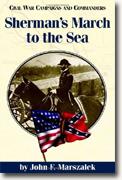Sherman's March To The Sea
John F. Marszalek
book reviews:
· general fiction
· chick lit/romance
· sci-fi/fantasy
· graphic novels
· nonfiction
· audio books
· author interviews
· children's books @
curledupkids.com
· DVD reviews @
curledupdvd.com
newsletter
win books
buy online
links
home
for authors
& publishers
for reviewers

 |
Sherman's March To The Sea (Civil War Campaigns and Commanders) John F. Marszalek McWhiney Foundation Paperback 160 pages July 2005 |
|
Most people in the South, especially in Georgia and the Carolinas, cringe when they hear the name General Sherman. Many think of him as that evil Union general who destroyed Southerners’ homes and property. This book tries to set the record straight: he was somewhat involved in the destruction that occurred, but his part of it was limited and he tried to control his army’s conduct. Much of the destruction blamed on Sherman and his army was really committed by Confederates and ordinary people who turned into criminals.
General Sherman agreed with General Grant, who was in charge of the Union Army, to use methods they had used in their previous campaigns - to destroy the property of those who supported the rebellion. This did not involve killing as many people as possible but did bring the war to the civilians who supported the rebellion, not just the soldiers, as was the custom up to that point. This involved psychological warfare. They both wanted to end the war as quickly as possible, and to them this seemed the best way to do so. Sherman’s Army of the Tennessee was to march from Atlanta to Savannah. They would not bring along a huge wagon train to carry provisions for the Army but instead live off of the land and its people. They were to forage for their food; Sherman gave strict orders not to harm the people unless they resisted. The foragers were to take only what was needed and leave some food for the people. Of course, many foragers broke this rule and took all the food and other items they wanted. Marszalek also discusses the issue of escaped slaves following Sherman’s army. Sherman did not want them to follow him because he could not provide them food and they would slow his army down. Marszalek also discusses the aftermath of the March and Sherman’s reputation. John F. Marszalek is the Giles Distinguished Professor Emeritus of history at Mississippi State University. He is the author of the upcoming August 2006 A Black Congressman in the Age of Jim Crow and of Commander of All Lincoln’s Armies: A Life of General Henry W. Halleck(2004), The Petticoat Affair (2000), Sherman’s Other War (1999), Sherman: A Soldier’s Passion for Order (1994), and other books and articles. This book is the twenty-sixth addition to the Civil War Campaigns and Commanders series. Like previous titles in the series, this is a good book. It provides 35 black and white illustrations of people covered in the book and other drawings and photographs from the Civil War period. This book has one black and white map of the March from Atlanta to the sea and it provides 20 biographical sketches with photographs or some illustration of the person being discussed. Marszalek provides a short index plus six and a half pages of bibliographical references. He also provides two appendices: Appendix A covers songs and poems written about Sherman and the March, while Appendix B is a list of those in Sherman’s Army. This book is a joy to read, not a complicated or dry history of the March. Civil War enthusiasts will like this book. Originally published on Curled Up With A Good Book at www.curledup.com. © Br. Benet Exton, O.S.B., 2006 |
|
|
|
 Click here to learn more about this month's sponsor! |
|
| fiction · sf/f · comic books · nonfiction · audio newsletter · free book contest · buy books online review index · links · · authors & publishers reviewers |
|
| site by ELBO Computing Resources, Inc. | |
 For instance, the burning of Atlanta was actually an accident that started when General Sherman decided not to leave a garrison in Atlanta. He intended to destroy anything that a Confederate army might use if it recaptured Atlanta; in the process of destroying military items, some hidden ammunition caught fire and spread to other nearby buildings. Criminals took advantage the situation to loot and cause trouble before Union troops could stop it. According to author John F. Marszalek, only thirty percent of Atlanta was destroyed - most homes were not damaged or received only light damage; businesses suffered the most.
For instance, the burning of Atlanta was actually an accident that started when General Sherman decided not to leave a garrison in Atlanta. He intended to destroy anything that a Confederate army might use if it recaptured Atlanta; in the process of destroying military items, some hidden ammunition caught fire and spread to other nearby buildings. Criminals took advantage the situation to loot and cause trouble before Union troops could stop it. According to author John F. Marszalek, only thirty percent of Atlanta was destroyed - most homes were not damaged or received only light damage; businesses suffered the most.